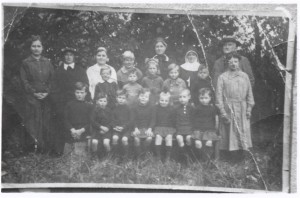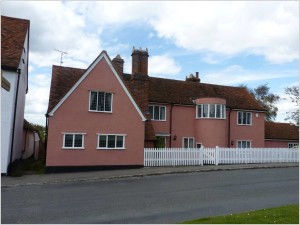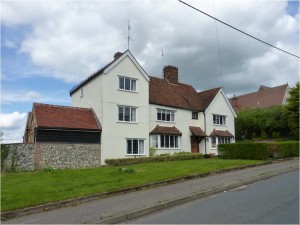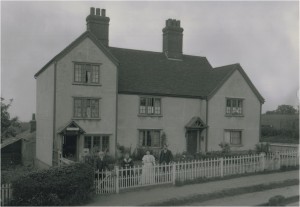A report by Darren Stone
In 2014 I found out about a Maternity home in Great Easton – around the time of the First World War – and decided to do some more research on it.
After many visits to the Essex Record Office in Chelmsford and much on-line research I have found that there were two homes in Great Easton as follows-
The Maternity Home
The first mention of a Maternity home in Great Easton appears in the Baptism records of the Church of St John and St Giles in 1897 where a number of babies are listed for baptism and – unusually – only the mothers’ names are listed and not the fathers. Also there are a number of multiple baptisms on the same day and some are listed as ‘From the Garth’. The Garth is a house on the village green in Great Easton.
I have found out that the house we know as ‘The Garth’ was originally two houses called ‘Bakers’ and ‘The Middle House’. The Garth name is first used in 1900 when the houses were combined into one. The Garth was bought and combined by a very wealthy aristocratic lady called Evelyn Duncombe (1842-1903).
http://www.npg.org.uk/collections/search/person/mp98073/evelyn-duncombe
Evelyn Duncombe came from a titled and religious family. Her father was Dean of York Minster and her maternal Grandfather was Marquess of Queensbury. She never married, but lived with her elderly mother in Berkley Square, Mayfair, London.
How this wealthy London lady came to own The Garth in Great Easton, Essex I do not yet know.
Was she was the force behind setting up the maternity home in the Garth?
I cannot find any records about the establishment of the Home, so I would be very interest to hear of any leads or old stories. Please email me at: [email protected]
NOTE: Evelyn Duncombe died in 1903 and the Garth was sold in 1905, and again in 1909. Then the Garth was owned by Beatrix Mary Simonds of Wolseys Farm, Duton Hill, and it became a children’s home whilst owned by her – see below. Also Beatrix Mary Simonds was a witness to Mary Catherine Rigby’s will so they were probably close friends.
In October 1898 the Baptism Records start giving the abode of the baptised child as ‘Great Easton Maternity Home’. I believe this is the house in Great Easton now called ‘Old House’ (below – photo taken in April 2015).
Below is a picture of Old House in approx. 1900. The left-hand part of the house was the Post Office, and the right-hand side may have been the Maternity Home for unmarried mothers.
The story of the Home is also the story of the ex-nun who ran the home – a remarkable lady called Mary Catherine Rigby. She was the daughter of a surgeon from Doncaster in Yorkshire. Born in 1858 in Doncaster to a well-to-do family, we find her in a convent in London in the 1891 census as a nun in the Anglican ‘All Saints Sisters of the Poor’ order based in Marleybone.
In an 1898 newspaper article from the Chelmsford Chronicle we find her ‘advertising’ for two vacancies at the maternity home; she also requests any donations of clothes for mothers and babies, which would be thankfully accepted by ‘Miss Rigby, Lady Superintendent’. Requests for Linen and clothes and fund raising events are often listed in the local newspapers.
A tragic entry from the Chelmsford Chronicle in September 1900 details the death of a small boy called Cecil Maurice Woodley (aged four months), who died after being bitten by a donkey in the garden of the home. He was buried in Great Easton churchyard.
In the 1901 census Mary Rigby is listed as ‘Superintendent’ of the Great Easton Maternity Home, with 6 mothers aged from 16 to 27, and 5 babies – all only a few months old. The census lists the mothers as being from Notts, London, Brighton and Devon – from all over the country – and they are servants or maids.
An article in the Chelmsford Chronicle dated 15 July 1904 reads as follows-
The Maternity Home, Great Easton
The object for this home is for the shelter and protection of young women about to become mothers for the first time who have previously borne good characters. The patron is the bishop of St Albans and the work is carefully superintended by Miss Rigby. The work has been carried on under many difficulties this last year, chiefly through the lack of funds. Miss Rigby earnestly appeals to mothers who have little ones of their own to help as far as they can these babies, who after the first three months of their lives, are deprived of a mothers love and care. To make the girls who are received in the home good mothers is surely the best way of preventing a second lapse into sin, to say nothing of the prevention of suffering to the helpless little ones. We trust Miss Rigby will be cheered by prompt and liberal help.’
This would suggest the babies are fostered out after 3 months. Was this the normal practice of the time, I wonder?
The 1911 census lists 11 girls and 8 babies at the Maternity Home. Mary Catherine Rigby is the head; Susan Duncombe is the matron. 11 girls are listed as ‘patients’ (aged from 16 to 29 years old) and 8 babies from 7 months to 3 days old.
Another newspaper article from The Chelmsford Chronicle dated 3 November 1911 says-
Easton Maternity Home. Bishop and the poor.
Yesterday the Bishop of Colchester presided over a meeting at the vestry hall, Braintree in aid of the Great Easton Maternity home. Some people objected to such a house as being an incentive to vice, but it should be remembered that in many cases the girls themselves were deliberately sinned against. The girls, when most susceptible, were brought under kindly influence, and were kept there for six months. At the present time there were two children aged 14 years in the Easton home who were expecting to become mothers; they had been the subject of deliberate assault. Could it be said that to help such cases was to aid vice? Many of the poorer classes lived under conditions where vice was almost unavoidable. It was part of the redemptive work to secure better conditions for those who had once fallen. For others more deeply fallen there was the home at Great Maplestead.
By the home at Easton there was a effort to restore the fallen to the paths of virtue and that could not possibly be called the encouragement of vice.
St Michael’s and All Angels Home for Children and Invalids
In the 1914 Kelly’s Directory ( a sort of early yellow pages and ‘Who’s Who’), the Maternity Home is mentioned and so is The Garth as ‘St Michael and All Angels’ Home for Children and Invalids, with a sister Fanny Francis in charge. Again in the 1917 and 1922 Kelly’s directory St Michael’s is mentioned but NOT in the 1926 edition.
The picture below was kindly lent by Alf Wright from his collection and shows a group of children and adults.

The only person we can safely identify is the Rev. Horatio Bladen Capel (1839-1933), on the right at the back. The Rev. Capel was rector of Great Easton from 1877 to 1918. Can we assume that the nun next to him was Sister Fanny Francis who was in charge of the Garth and that the picture shows the children from the home?
Do you know anyone in the picture? If you can help with identification, do get in touch.
It seems that in 1923 or thereabouts the St Michael’s Home at the Garth was no longer in operation, as the house was occupied then by a Mr Cash, a Labour Party candidate and his agent.
The Maternity Home at ‘Old House’ was still going though, despite Mary Catherine Rigby being seriously injured in a pony and trap incident in Dunmow High Street in 1920. A number of paternity court cases are listed in the Chelmsford Chronicle in the 1920s, with the babies being born at the Great Easton Maternity Home.
Closure Of Maternity Home
The Maternity Home at Old House closed in December 1924, and a new home was set up in Coggeshall, Essex – called the Red House.
Mary Catherine Rigby continued to live in Great Easton after the closure of the Maternity Home, and in a newspaper report of 1927 – and again in 1933 – there are court cases which report girls stealing from her. Perhaps she kept some girls on after the home had officially closed?
Mary Catherine Rigby died in June 1939, aged 80, and is buried in Great Easton Churchyard.
In the absence – so far – of finding any official records for the Maternity Home and the Children’s Home, I have built up a list of names of the children baptized at Great Easton church from the Home, and also of their mothers (who were listed in the church baptism records). I have also made a list of babies and mothers buried in the churchyard from the home. Additionally, I have compiled information about some mothers and babies from the Home from various enquiries over the internet.
I am still trying to piece together the origins of the Maternity Home and the Children’s Home, and to find out how they functioned and were financed. So I would be very interested to hear from anyone researching their relatives who comes across Great Easton maternity home listed as place of birth on the birth certificate.
Do please get in touch if you have anything you would like to contribute to this research.
Darren Stone 2016 / [email protected]
Last updated 24th July 2018



